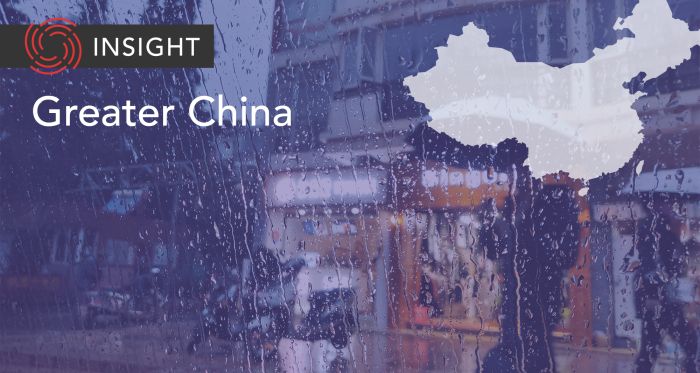The Takeaway
While the record-breaking rains that pummelled northern China for days have now receded, the aftermath has raised questions about how the country will cope with future extreme weather events. Policymakers are now examining how disaster prevention and mitigation can be more inclusive and how greater transparency can help prevent the abuse of flood relief funds.
In Brief
Typhoon Doksuri’s extreme winds and deadly rains swept through much of north and northeast China between late July and early August, causing severe floods and landslides and extensive damage to homes, crops, livestock, and infrastructure. Making landfall at the southeast province of Fujian on the morning of July 28, Doksuri continued northward toward Beijing, Tianjin, and Hebei — where the amount of rainfall smashed a 140-year record — before reaching the northeast provinces of Jilin, Liaoning, and Heilongjiang. The torrential rains eventually died down on August 4. However, rescue efforts remained in full effect, with first responders and volunteers continuing to search for missing people, leading clean-up operations, and supporting the millions displaced by the typhoon.
The latest numbers, reported by state media, paint a grim picture of Doksuri’s impact. In Beijing, 18 people remain missing and 33 have died as of August 11. Neighbouring Hebei province reported 16 missing and 29 dead, as well as 3.89 million people affected and 3,197 square kilometres of crops — an area more than half the size of Prince Edward Island — damaged. Many media outlets have noted that rescue operations in these areas have been particularly challenging, with remote villages being cut off from roads, electricity, and telecommunications. Similar issues have been reported in the northeastern province of Heilongjiang, where 374,049 people have been displaced and 2,580 sq. km of farmland have been affected. The town of Wuchang, known as the ‘hometown of rice,’ was the hardest hit in the province, and farmers have estimated that each household in the area suffered at least C$27,800 (150,000 yuan) in losses due to the tropical storm. Roughly two weeks after Doksuri arrived in China, Typhoon Khanun brought more rainfall to many impacted regions.
Implications
The government’s response to the deadly typhoon has been swift. On August 1, Chinese President Xi Jinping released a statement requesting that local authorities and responders “make every effort” to rescue, treat, and settle affected residents while repairing damaged infrastructure. Xi also stressed the importance of strengthening early-warning and flood-prevention systems during this critical period. By August 11, the ministries of finance and emergency management had allocated a total of C$1.44 billion (7.738 billion yuan) to help support relief work and flood prevention.
However, on-the-ground stories suggest that more work is needed to improve China’s disaster response. To many, Typhoon Doksuri highlighted the different challenges rural areas face during extreme weather compared to urban centres. Many of the hardest-hit locales were mountainous villages that saw the destruction of “lifeline” infrastructure, which was not built to withstand heavy flooding. A viral video of a building collapsing in Hebei province, with an estimated 300 people trapped inside, also sparked public discussion on the need for more disaster-resilient infrastructure in these countryside areas, which are typically less prone to flooding. At the same time, residents impacted by the typhoon pointed out that while authorities tried sending notices in WeChat groups or knocking on villagers’ doors, some were either not properly warned of the flood’s severity or were notified too late to take action. Those who did manage to escape say that they could have better protected their houses or businesses if they had been notified earlier.
Meanwhile, a more serious concern lingers about the use of relief money, as distrust and criticism of the government were reinforced when news broke on August 2 about the misappropriation of relief funds earmarked for the 2021 megafloods in Henan. A bombshell government audit revealed that officials in more than 70 counties improperly used C$1.8 billion (9.6 billion yuan) in relief funds. Despite having pledged to manage and account for the relief funds in the aftermath of the deadly 2021 disaster, provincial authorities failed to identify the corruption for two years, leaving auditors as the last line of defence. As government money flows to rebuild the regions affected by Typhoon Doksuri, many are worried that a similar misuse of funds could occur.
What’s Next
- China must improve its climate resilience
With the rising frequency of heavy rain, sandstorms, heat waves, and other extreme weather phenomena, China will likely begin investing far more resources into building climate resilience. By 2050, China is expected to be one of the most vulnerable countries to climate-related disasters, meaning drastic action is needed.
- Rural areas need more attention in disaster planning
While some ‘netizens’ blame Beijing’s flood discharge system for pushing floodwater into surrounding areas, hydrological experts are calling for a more balanced consideration of urban-rural interests when such events take place, especially in rural areas where disaster warning and response capacities can be substandard.
- Government’s checks and balances under public scrutiny
Henan has vowed to produce a rectification report on the misused funds from 2021 by the end of November. The public, however, remains skeptical about such a report. Some expect data to be altered to paint a rosier picture of the scandal, and question if the report will truly bring about long-lasting change. As government funds and private donations pour into recently affected regions, calls for more transparency and accountability are expected to get louder.
• Produced by CAST’s Greater China team: Maya Liu (Program Manager); Dustin Lo (Analyst); and Chloe Yeung (Analyst).





